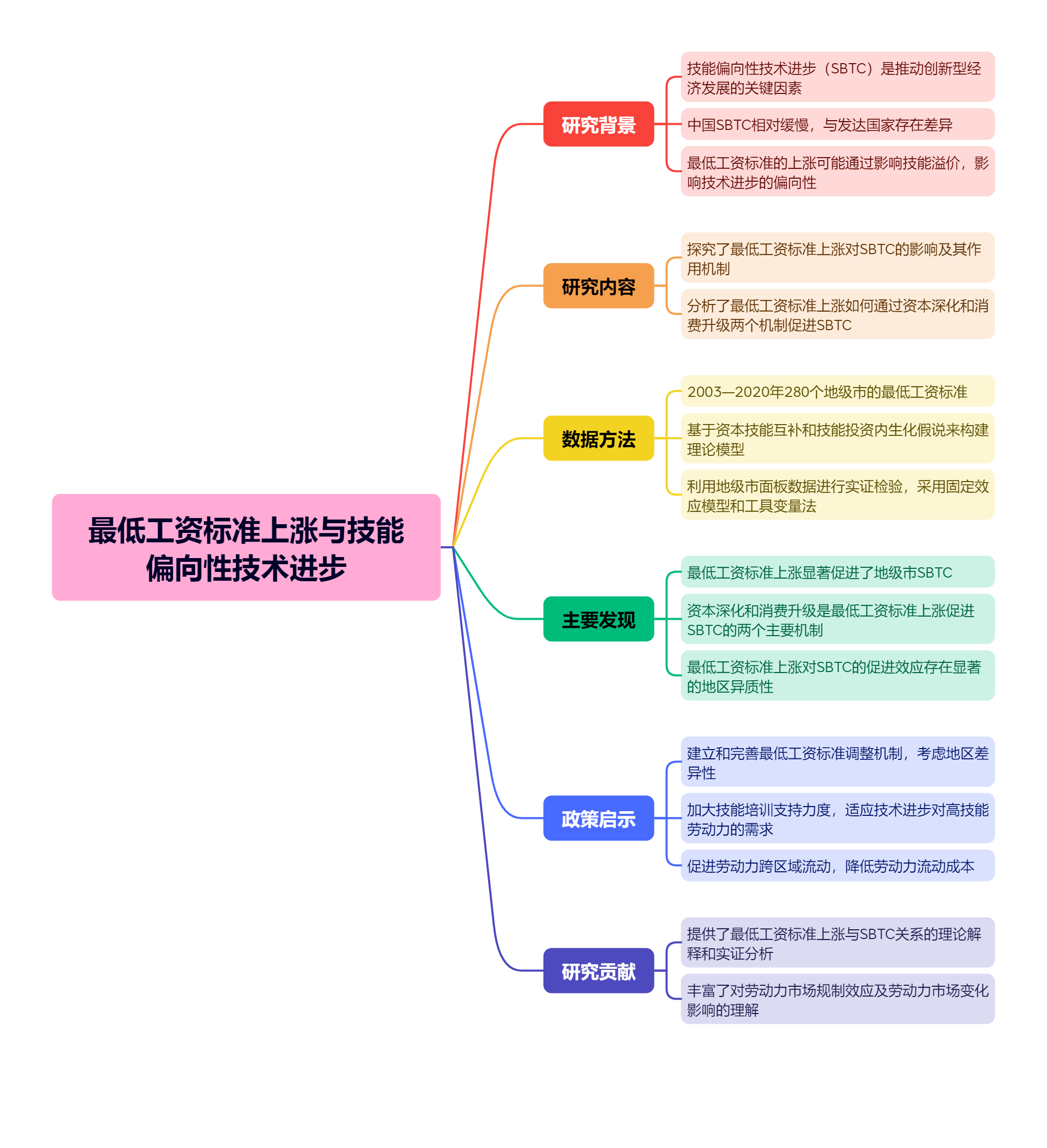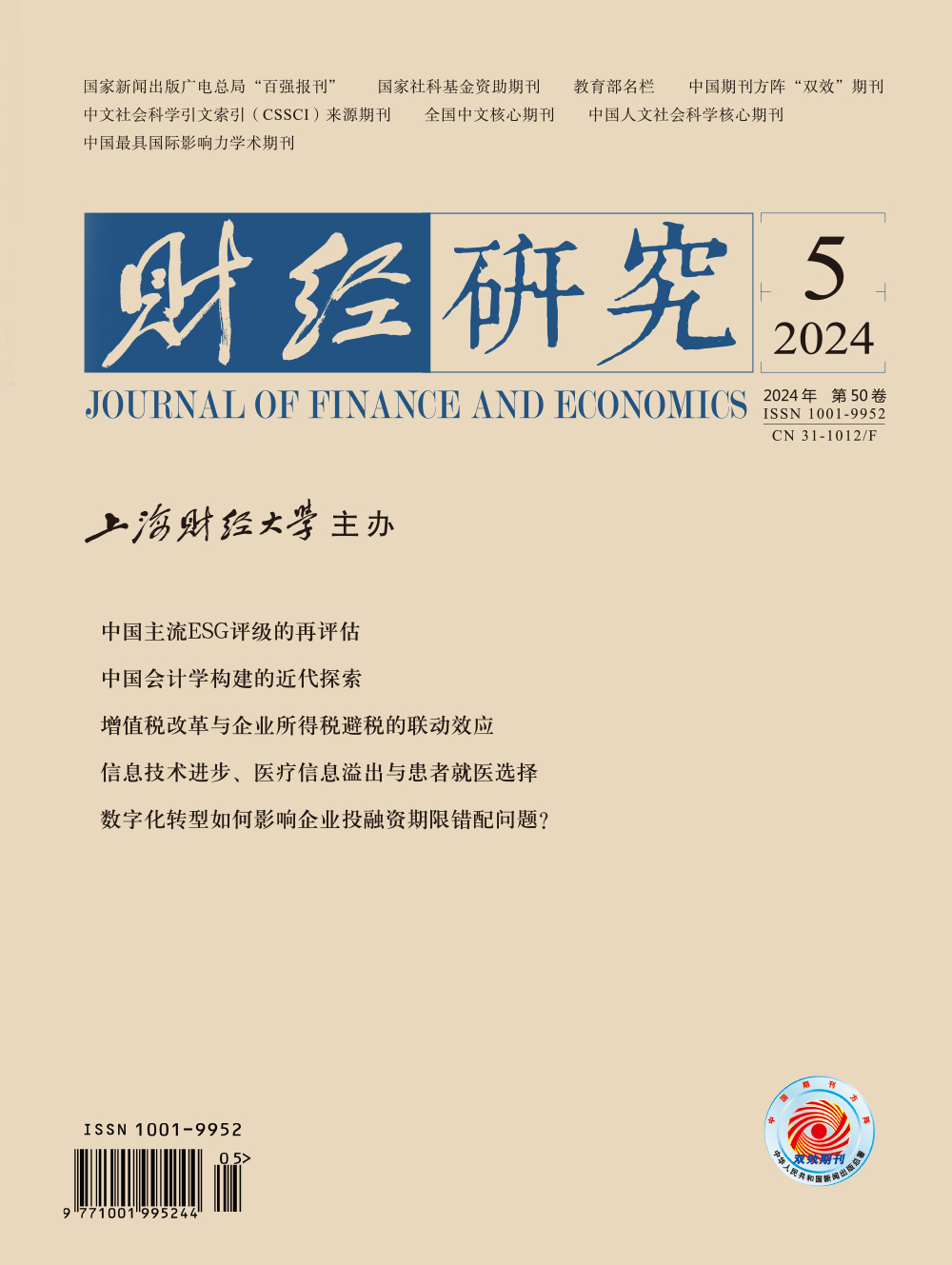技能偏向性技术进步(SBTC)是创新型经济发展的基本动力。文章把最低工资标准上涨引致的短期内技能溢价下降纳入包含非中性技术进步的一般均衡增长模型,基于资本技能互补和技能投资内生化假说,从微观层面揭示了最低工资标准上涨促进SBTC的作用机理。在手动收集2003—2020年280个地级市最低工资标准并对地级市SBTC进行合理估算的基础上,利用地级市面板数据对理论假说进行了实证检验。结果表明,最低工资标准上涨显著促进了地级市SBTC的发展;最低工资标准上涨通过资本深化和消费升级两个机制合力促进了技术进步的技能偏向水平;最低工资标准上涨的SBTC促进效应存在显著的地区异质性特征。文章的研究对充分理解中国劳动力市场变化所产生的深远影响、劳动力市场规制的政策效应及实体经济转型发展具有重要启示。
最低工资标准上涨与技能偏向性技术进步——基于资本技能互补和技能投资内生化假说
摘要
参考文献
相关附件
思维导图
6 柯善咨,向娟. 1996-2009年中国城市固定资本存量估算[J]. 统计研究,2012,(7):19−24. DOI:10.3969/j.issn.1002-4565.2012.07.004
15 魏下海,万江滔,余玲铮. 劳动力成本上涨与制造业企业技术选择方向[J]. 财贸经济,2023,(1):154−168. DOI:10.3969/j.issn.1002-8102.2023.01.010
23 Acemoglu D. Directed technical change[J]. The Review of Economic Studies,2002,a,69(4):781−809.
24 Acemoglu D. Technical change,inequality,and the labor market[J]. Journal of Economic Literature,2002,b,40(1):7−72.
25 Antonelli C,Quatraro F. The effects of biased technological change on total factor productivity:Empirical evidence from a sample of OECD countries[J]. The Journal of Technology Transfer,2010,35(4):361−383. DOI:10.1007/s10961-009-9134-2
26 Chu A C,Cozzi G,Furukawa Y. Effects of economic development in China on skill-biased technical change in the US[J]. Review of Economic Dynamics,2015,18(2):227−242. DOI:10.1016/j.red.2014.04.001
27 Cozzi G,Impullitti G. Government spending composition,technical change,and wage inequality[J]. Journal of the European Economic Association,2010,8(6):1325−1358. DOI:10.1162/jeea_a_00027
28 Eicher T S,Turnovsky S J. Convergence in a two-sector nonscale growth model[J]. Journal of Economic Growth,1999,4(4):413−428. DOI:10.1023/A:1009867409614
29 Freeman R B,Kleiner M M. The last American shoe manufacturers:Decreasing productivity and increasing profits in the shift from piece rates to continuous flow production[J]. Industrial Relations:A Journal of Economy and Society,2005,44(2):307−330. DOI:10.1111/j.0019-8676.2005.00385.x
30 Harasztosi P,Lindner A. Who pays for the minimum wage?[J]. American Economic Review,2019,109(8):2693−2727. DOI:10.1257/aer.20171445
31 Jones C I,Romer P M. The new kaldor facts:Ideas,institutions,population,and human capital[J]. American Economic Journal:Macroeconomics,2010,2(1):224−245. DOI:10.1257/mac.2.1.224
32 Krusell P,Ohanian L E,Ríos-Rull J V,et al. Capital-skill complementarity and inequality:A macroeconomic analysis[J]. Econometrica,2000,68(5):1029−1053. DOI:10.1111/1468-0262.00150
33 Mayneris F,Poncet S,Zhang T. Improving or disappearing:Firm-level adjustments to minimum wages in China[J]. Journal of Development Economics,2018,135:20−42. DOI:10.1016/j.jdeveco.2018.06.010
34 Nunn N,Qian N. The potato's contribution to population and urbanization:Evidence from a historical experiment[J]. The Quarterly Journal of Economics,2011,126(2):593−650. DOI:10.1093/qje/qjr009
35 Shen C M,Zheng J H. Does global value chains participation really promote skill-biased technological change? Theory and evidence from China[J]. Economic Modelling,2020,86:10−18. DOI:10.1016/j.econmod.2019.03.009
36 Young A. Gold into base metals:Productivity growth in the People’s Republic of China during the reform period[J]. Journal of Political Economy,2003,111(6):1220−1261. DOI:10.1086/378532
引用本文
沈春苗, 曾红丽, 郑江淮. 最低工资标准上涨与技能偏向性技术进步——基于资本技能互补和技能投资内生化假说[J]. 财经研究, 2024, 50(5): 124-138.
导出参考文献,格式为:
下一篇:风险投资的溢出效应





 4651
4651  8684
8684


